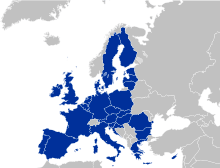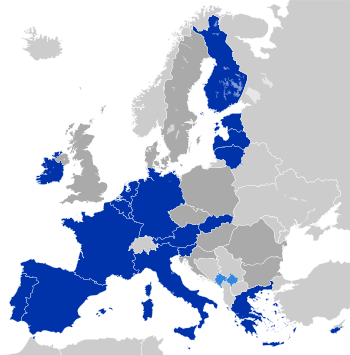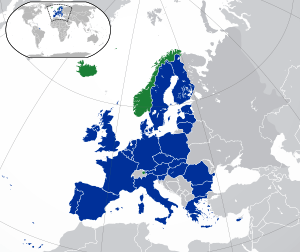Single European Act
| Single European Act | |
|---|---|
| Type | Amending treaty |
| Signed |
17 February 1986 28 February 1986 |
| Location |
Luxembourg, Luxembourg The Hague, Netherlands |
| Effective | 1 July 1987 |
| Parties | |
| Depositary | Government of Italy |
| Citations |
Prior amendment treaty: Merger Treaty (1965) Subsequent amendment treaty: Maastricht Treaty (1992) |
| Languages | |
|
| |
|
After amendments made by the SEA Treaty: Consolidated version of EURATOM treaty (1986) Consolidated version of the ECSC treaty (1986) Consolidated version of TEEC (1986) | |
The Single European Act (SEA) was the first major revision of the 1957 Treaty of Rome. The Act set the European Community an objective of establishing a single market by 31 December 1992, and codified European Political Cooperation, the forerunner of the European Union's Common Foreign and Security Policy. It was signed at Luxembourg on 17 February 1986, and at The Hague on 28 February 1986. It came into effect on 1 July 1987, under the Delors Commission.
A core element of the SEA was to create a single market within the European Community by 1992, when – it was hoped – the legislative reforms seen necessary would have been completed. To make the objectives possible, the SEA reformed the legislative process both by introducing the cooperation procedure and by extending Qualified Majority Voting to new areas. Measures were also taken to shorten the legislative process.
The SEA intended to remove barriers and to increase harmonisation and competitiveness among its countries.
Background
The SEA's signing grew from the discontent among European Community members in the 1980s about the de facto lack of free trade among them. Leaders from business and politics wanted to harmonise laws among countries and resolve policy discrepancies.
The Treaty was drafted with the aim of implementing parts of the Dooge report on institutional reform of the Community and the European Commission's white paper on reforming the Common Market. The resultant treaty aimed to create a "Single Market" in the Community by 1992, and as a means of achieving this adopted a more collaborative legislative process, later known as the cooperation procedure, which gave the European Parliament a real say in legislating for the first time and introduced more majority voting in the Council of Ministers.[1] Under the procedure the Council could, with the support of Parliament and acting on a proposal by the Commission, adopt a legislative proposal by a qualified majority, but the Council could also overrule a rejection of a proposed law by the Parliament by adopting a proposal unanimously.[2]
Signing and ratification
A political agreement was reached at the European Council held in Luxembourg on 3 December 1985 when foreign ministers finalised the text. Denmark and Italy raised concerns over constitutional validity. Nine countries, Belgium, the Federal Republic of Germany (FRG), France, Ireland, Luxembourg, the Netherlands, Portugal, Spain, and the United Kingdom, signed the Single European Act at Luxembourg on 17 February 1986.[3] That date has been originally intended as display of unity within the Community regarding the SEA,[4] but this failed.
The Danish parliament rejected the Single Act in January 1986 after an opposition motion calling for the then unsigned document to be renegotiated was passed by 80 votes to 75.[5] The Danish opposition opposed the treaty because they said it would increase the powers of the European Parliament.[5] The Danish government, who supported the treaty, decided to hold a national, non-binding referendum on the issue in order to overcome the treaty's rejection by the Danish parliament. This referendum was duly held on 27 February 1986 and approved by the Danish people by 56.2% voting in favour to 43.8% against on a turnout of 75.4%.
Italian government delayed in signing for the opposite concern: that, in their opinion, it would not give the European Parliament enough power.[4] Together with Greece who had also delayed in signing, Denmark and Italy signed the Single Act at The Hague on 28 February 1986.
It had been originally intended to have the SEA ratified by the end of 1986 so that it would come into force on 1 January 1987 and 11 of the then 12 member states of the EEC had ratified the treaty by that date.[6] The deadline failed to be achieved when the Irish government were restrained from ratifying the SEA pending court proceedings.[7]
In the court case, the Irish Supreme Court ruled that the Irish Constitution would have to be amended before the state could ratify the treaty, something that can only be done by referendum. Such a referendum was ultimately held on 26 May 1987 when the proposal was approved by Irish voters, who voted by 69.9% in favour to 30.1% against, on a turnout of 44.1%. Ireland formally ratified the Single European Act in June 1987, allowing the treaty to come into force on 1 July.
Treaty time line
| Signed: In force: Document: |
1947 1947 Dunkirk Treaty |
1948 1948 Brussels Treaty |
1951 1952 Paris Treaty |
1954 1955 Modified Brussels Treaty |
1957 1958 Rome Treaty & EURATOM |
1965 1967 Merger Treaty |
1975 1976 Council Agreement on TREVI |
1986 1987 Single European Act |
1985+90 1995 Schengen Treaty & Convention |
1992 1993 Maastricht Treaty (TEU) |
1997 1999 Amsterdam Treaty |
2001 2003 Nice Treaty |
2007 2009 Lisbon Treaty |
|||
| Content: | (est. alliance) | (founded WU) | (founded ECSC) | (protocol amending WU to become WEU) | (founded EEC and EURATOM) | (merging the legislative & administrative bodies of the 3 European communities) | (founded TREVI) | (amended: EURATOM, ECSC, EEC)+ (founded EPC) |
(founded Schengen) (implemented Schengen) |
(amended: EURATOM, ECSC, and EEC to transform it into EC)+ (founded: JHA+CFSP) |
(amended: EURATOM, ECSC, EC to also contain Schengen, and TEU where PJCC replaced JHA) | (amended with focus on institutional changes: EURATOM, ECSC, EC and TEU) | (abolished the 3 pillars and WEU by amending: EURATOM, EC=>TFEU, and TEU) (founded EU as an overall legal unit with Charter of Fundamental Rights, and reformed governance structures & decision procedures) |
|||
| Three pillars of the European Union: | ||||||||||||||||
| European Communities (with a single Commission & Council) |
||||||||||||||||
| European Atomic Energy Community (EURATOM) | ||||||||||||||||
| European Coal and Steel Community (ECSC) | Treaty expired in 2002 | European Union (EU) | ||||||||||||||
| European Economic Community (EEC) | European Community (EC) | |||||||||||||||
| Schengen Rules | ||||||||||||||||
| Terrorism, Radicalism, Extremism and Violence Internationally (TREVI) | Justice and Home Affairs (JHA) |
Police and Judicial Co-operation in Criminal Matters (PJCC) | ||||||||||||||
| European Political Cooperation (EPC) | Common Foreign and Security Policy (CFSP) | |||||||||||||||
| Franco-British alliance | Western Union (WU) | Western European Union (WEU) | ||||||||||||||
| Treaty terminated in 2011 | ||||||||||||||||
See also
References
- ↑ Craig, Paul; de Burca, Grainne (2003). EU Law: Text, Cases and Materials (3rd ed.). Oxford, New York: Oxford University Press. p. 143. ISBN 0-19-925608-X.
- ↑ Article 7 of the Single European Act amending Article 7 of the Treaty establishing the European Economic Community.
- ↑ "The signing of the Single European Act". CVCE. Retrieved 4 May 2013.
- 1 2 Boland, Colm (17 February 1986). "Ireland to sign EEC foreign policy treaty today". The Irish Times.
- 1 2 "Danish Parliament votes to reject EEC reforms". The Irish Times. 22 January 1986. p. 5.
- ↑ Carroll, Joe (31 December 1986). "Single Act ratified by 11 states". The Irish Times. p. 13.
- ↑ Carroll, Joe (25 December 1986). "Court delays ratification of European Act". The Irish Times. p. 1.
External links
- Text of the Single European Act
- The History of the European Union – The Single European Act
- The Single European Act on CVCE website (Centre for European Studies)
- Irish referendum of 26 May 1987
- Single European Act, Treaty available in ECOLEX-the gateway to environmental law (English)




